A) Cab > 12 µF
B) Cab > CX
C) 5 µF < Cab < 12 µF
D) Cab < 5 µF
E) Cab < CX
G) A) and B)
Correct Answer

verified
Correct Answer
verified
Multiple Choice
Identical light bulbs can be attached to identical ideal batteries in three different ways (A, B, orC) , as shown in the figure. The ranking (from lowest to highest) of the total power produced by the battery is
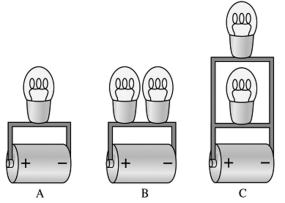
A) B, A, C
B) A, B, C
C) C, B, A
D) A, C, B
F) B) and D)
Correct Answer

verified
Correct Answer
verified
Multiple Choice
A 3.0-Ω resistor is connected in parallel with a 6.0-Ω resistor. This combination is then connected in series with a 4.0-Ω resistor. The resistors are connected across an ideal 12-volt battery. How much power is dissipated in the 3.0-Ω resistor?
A) 2.7 W
B) 5.3 W
C) 6.0 W
D) 12 W
F) C) and D)
Correct Answer

verified
Correct Answer
verified
Multiple Choice
Four resistors having resistances of 20 Ω, 40 Ω, 60 Ω, and 80 Ω are connected in series across an ideal 50-V dc source. What is the current through each resistor?
A) 0.25 A
B) 0.50 A
C) 0.75 A
D) 2.0 A
E) 4.0 A
G) A) and E)
Correct Answer

verified
Correct Answer
verified
Multiple Choice
A15-Ω resistor is connected in parallel with a 30-Ω resistor. If this combination is now connected in series with an ideal 9.0-V battery and a 20-Ω resistor, what is the current through the 15-Ω resistor?
A) 0.10 A
B) 0.13 A
C) 0.20 A
D) 0.26 A
F) B) and D)
Correct Answer

verified
Correct Answer
verified
Multiple Choice
Four unequal resistors are connected in a parallel with each other. Which one of the following statements is correct about this combination?
A) The equivalent resistance is less than that of the smallest resistor.
B) The equivalent resistance is equal to the average of the four resistances.
C) The equivalent resistance is midway between the largest and smallest resistance.
D) The equivalent resistance is more than the largest resistance.
E) None of the other choices is correct.
G) A) and B)
Correct Answer

verified
Correct Answer
verified
Multiple Choice
Draw a circuit with two batteries, a resistor between them, and a capacitor in parallel with the resistor. The batteries are connected negative pole to positive pole.
A) ![]()
B) ![]()
C) ![]()
D) ![]()
F) A) and B)
Correct Answer

verified
Correct Answer
verified
Multiple Choice
Each of the resistors shown in the figure has a resistance of
What is the equivalent resistance between points a and b of this combination? 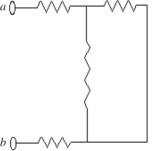
A) 450.0 Ω
B) 720.0 Ω
C) 540.0 Ω
D) 180.0 Ω
F) A) and C)
Correct Answer

verified
Correct Answer
verified
Multiple Choice
A charged capacitor is connected in series with a resistor and an open switch. At time t = 0 s, the switch is closed. Which of the graphs below best describes the potential difference V across the resistor as a function of time t?
A) ![]()
B) ![]()
C) ![]()
D) ![]()
E) ![]()
G) C) and D)
Correct Answer

verified
Correct Answer
verified
Multiple Choice
A capacitor C is connected in series with a resistor R across a battery and an open switch. If a second capacitor of capacitance 2C is connected in parallel with the first one, the time constant of the new RC circuit will be
A) the same as before.
B) twice as large as before.
C) three times a large as before.
D) one-half as large as before.
E) one-fourth as large as before.
G) A) and E)
Correct Answer

verified
Correct Answer
verified
Multiple Choice
When unequal resistors are connected in parallel in a circuit,
A) the same current always runs through each resistor.
B) the potential drop is always the same across each resistor.
C) the largest resistance has the largest current through it.
D) the power generated in each resistor is the same.
F) All of the above
Correct Answer

verified
Correct Answer
verified
Multiple Choice
What is the magnitude of the potential difference between points C and D for the circuit shown in the figure? The battery is ideal, and all the numbers are accurate to two significant figures. 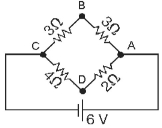
A) 6.0 V
B) 4.0 V
C) 3.0 V
D) 2.0 V
F) C) and D)
Correct Answer

verified
Correct Answer
verified
Multiple Choice
Determine the current in the 7.0-Ω resistor for the circuit shown in the figure. Assume that the batteries are ideal and that all numbers are accurate to two significant figures. 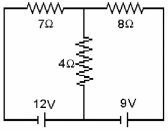
A) 0.28 A
B) 1.3 A
C) 1.6 A
D) 2.1 A
F) B) and C)
Correct Answer

verified
Correct Answer
verified
Multiple Choice
For the circuit shown in the figure, V = 60 V, C = 20 µF, R = 0.10 MΩ, and the battery is ideal. Initially the switch S is open and the capacitor is uncharged. The switch is then closed at time t = 0.00 s. What is the charge on the capacitor 8.0 s after closing the switch? 
A) 1200 µC
B) 940 µC
C) 1400 µC
D) 1600 µC
E) 1900 µC
G) None of the above
Correct Answer

verified
Correct Answer
verified
Multiple Choice
A 5.0-μF, a 14-μF, and a 21-μF capacitor are connected in series. How much capacitance would a single capacitor need to have to replace the three capacitors?
A) 40 μF
B) 3.6 μF
C) 2.0 μF
D) 3.1 μF
F) A) and C)
Correct Answer

verified
Correct Answer
verified
Multiple Choice
For the circuit shown in the figure, V = 60 V, C = 40 µF, R = 0.90 MΩ, and the battery is ideal. Initially the switch S is open and the capacitor is uncharged. The switch is then closed at time t = 0.00 s. At a given instant after closing the switch, the potential difference across the capacitor is twice the potential difference across the resistor. At that instant, what is the charge on the capacitor? 
A) 1600 µC
B) 1400 µC
C) 1200 µC
D) 890 µC
E) 600 µC
G) B) and D)
Correct Answer

verified
Correct Answer
verified
Multiple Choice
The network shown is assembled with uncharged capacitors X , Y, and Z, with and The switches S1 and S2 are initially open, and a potential difference Vab = 120 V is applied between points a and b. After the network is assembled, switch S1 is then closed, but switch S2 is kept open. How much energy is finally stored in capacitor X? 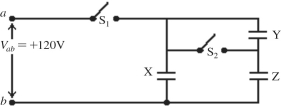
A) 29 mJ
B) 0.48 mJ
C) 0.24 mJ
D) 58 mJ
E) 0.96 mJ
G) B) and E)
Correct Answer

verified
Correct Answer
verified
Multiple Choice
A 2.0-μF capacitor that is initially uncharged is charged through a 50-kΩ resistor. How long does it take for the capacitor to reach 90% of its full charge?
A) 0.90 s
B) 0.23 s
C) 2.2 s
D) 2.3 s
F) B) and D)
Correct Answer

verified
Correct Answer
verified
Multiple Choice
A 5.0-μF capacitor and a 7.0-μF capacitor are connected in series across an 8.0-V potential source. What is the potential difference across the 5.0-μF capacitor?
A) 0 V
B) 8.0 V
C) 2.7 V
D) 3.6 V
E) 4.7 V
G) All of the above
Correct Answer

verified
Correct Answer
verified
Multiple Choice
Identical ideal batteries are connected in different arrangements to the same light bulb, as shown in the figure. For which arrangement will the bulb shine the brightest?
(A)
 (B)
(B)
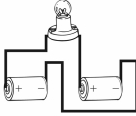 (C)
(C)

A) A
B) B
C) C
E) A) and C)
Correct Answer

verified
Correct Answer
verified
Showing 61 - 80 of 157
Related Exams